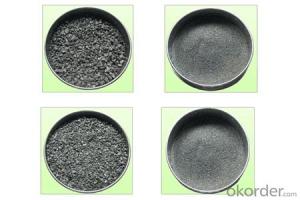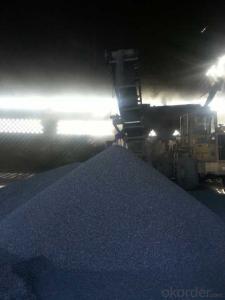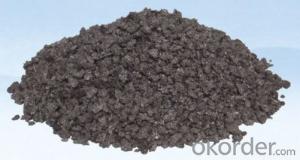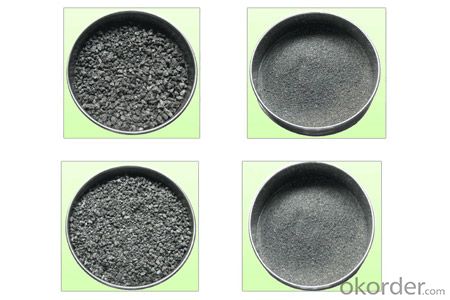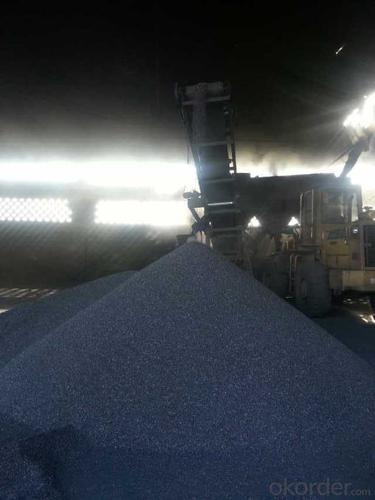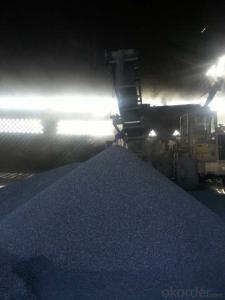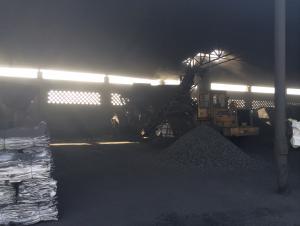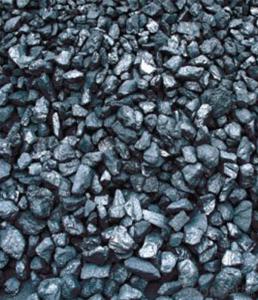Carbon Additive FC 90%-95% CNBM China Supplier
- Loading Port:
- Tianjin
- Payment Terms:
- TT OR LC
- Min Order Qty:
- 0 m.t.
- Supply Capability:
- 100000 m.t./month
OKorder Service Pledge
OKorder Financial Service
You Might Also Like
Packaging & Delivery
Packaging Detail: | 25kgs/50kgs/1ton per bag or as buyer's request |
Delivery Detail: | Within 20 days after receiving corect L/C |
Application
The Calcined Anthracite Coal/Gas Calcined Anthracite Coal/Carbon Raiser is mainly used in steelmaking in electrical stove, screening water, shipbuilding sandblast to remove rust. It can reduce the cost of steelmaking effectively by replacing the traditional petroleum coke of carburant.Also can improve the Carbon content in steel-melting and Ductile iron foundry.
Feature
All of our goods are made in the best quality of world famous Tianjin. All of our products are with High carbon, Low ash, low sulphur, Low Moisture.
Specifications
Calcined Anthracite
Fixed carbon: 90%-95%
S: 0.5% max
Size: 0-3. 3-5.3-15 or as request
PARAMETER UNIT GUARANTEE VALUE | |||||
F.C.% | 95MIN | 94MIN | 93MIN | 92MIN | 90MIN |
ASH % | 4MAX | 5MAX | 6MAX | 7MAX | 8MAX |
V.M.% | 1 MAX | 1MAX | 1.5MAX | 1.5MAX | 1.5MAX |
SULFUR % | 0.5MAX | 0.5MAX | 0.5MAX | 0.5MAX | 0.5MAX |
MOISTURE % | 0.5MAX | 0.5MAX | 0.5MAX | 0.5MAX | 0.5MAX |
Size can be adjusted based on buyer's request.
Picture
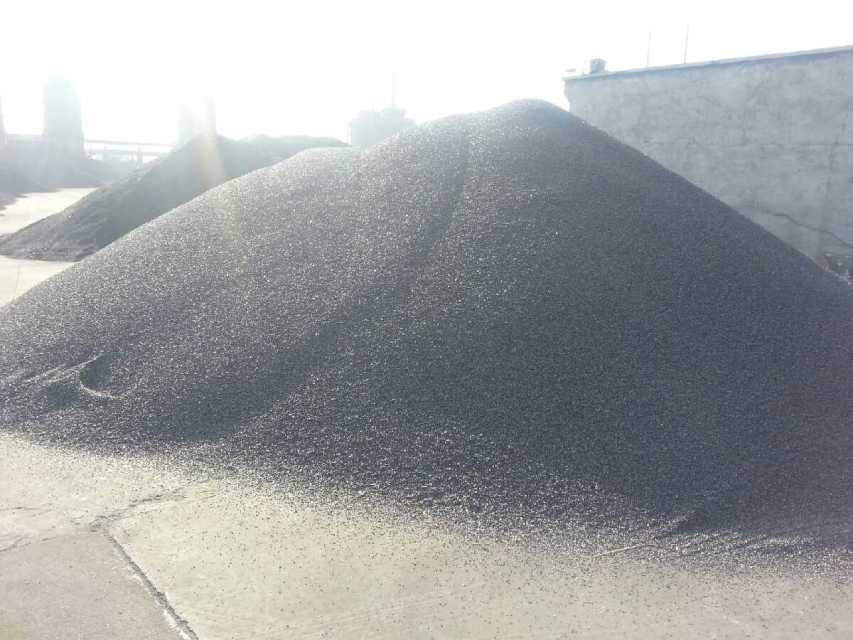
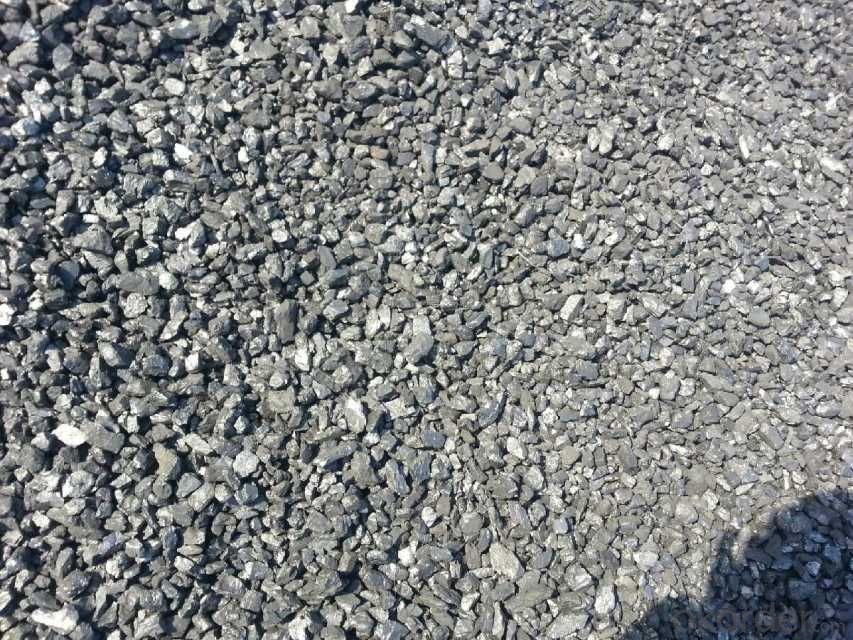
- Q: How does carbon contribute to the structure of DNA?
- Carbon is an essential element in the structure of DNA as it forms the backbone of the molecule. Carbon atoms in the sugar-phosphate backbone of DNA provide stability and flexibility, allowing the molecule to twist and fold into its double helix shape. Additionally, carbon atoms are also present in the nitrogenous bases, which are the building blocks of the genetic code. Overall, carbon's presence in DNA is crucial for its overall structure and function in storing and transmitting genetic information.
- Q: How does carbon impact the availability of natural resources?
- Carbon impacts the availability of natural resources by contributing to climate change. Excessive carbon emissions, primarily from burning fossil fuels, lead to global warming, which in turn affects the availability and distribution of resources such as water, food, and energy. Additionally, carbon pollution can cause ocean acidification, harming marine ecosystems and reducing fish populations. Therefore, controlling carbon emissions is crucial to ensure the sustainable availability of natural resources.
- Q: What are the impacts of carbon emissions on urban environments?
- Carbon emissions have significant impacts on urban environments. One of the most notable effects is air pollution. The release of carbon dioxide and other greenhouse gases from vehicles, factories, and power plants contributes to the formation of smog and harmful particulate matter in cities. This pollution poses serious health risks to residents, particularly those with respiratory conditions, and can lead to increased hospital admissions and premature deaths. Furthermore, carbon emissions contribute to climate change, which has wide-ranging consequences for urban areas. Rising temperatures and changing weather patterns can intensify heatwaves, leading to heat-related illnesses and deaths. Increased frequency and severity of extreme weather events, such as hurricanes and floods, can cause significant infrastructure damage and disrupt essential services like water supply and transportation. Urban areas also face the threat of rising sea levels due to carbon emissions. Coastal cities are particularly vulnerable to flooding and erosion as the melting of polar ice caps and thermal expansion of seawater continue. This can result in the loss of valuable land, displacement of populations, and damage to critical infrastructure, including buildings, roads, and sewage systems. Carbon emissions also contribute to the urban heat island effect, wherein cities experience higher temperatures compared to surrounding rural areas. This is due to the absorption and retention of heat by concrete, asphalt, and other urban materials. The urban heat island effect can exacerbate the health risks associated with heatwaves and increase energy demands for cooling, further contributing to carbon emissions. Finally, carbon emissions have economic impacts on urban environments. The costs of mitigating and adapting to the effects of climate change, such as implementing climate-resilient infrastructure and disaster response measures, can be significant. Additionally, the health consequences of air pollution and extreme weather events can lead to increased healthcare costs and productivity losses. To mitigate these impacts, efforts should be made to reduce carbon emissions through transitioning to cleaner energy sources, promoting sustainable transportation options, and implementing energy-efficient practices in buildings. Urban planning and design should also prioritize green spaces, tree planting, and the use of reflective and permeable materials to combat the urban heat island effect. By addressing carbon emissions in urban environments, we can create healthier, more resilient cities for both current and future generations.
- Q: What are the advantages of carbon-based nanoelectronics?
- Carbon-based nanoelectronics have several advantages. Firstly, carbon is an abundant and versatile element, making it cost-effective and readily available for large-scale production. Secondly, carbon-based materials, such as graphene and carbon nanotubes, possess exceptional electrical, thermal, and mechanical properties, enabling high-performance and efficient devices. Additionally, carbon-based nanoelectronics offer excellent flexibility and transparency, allowing for the development of flexible and wearable electronic devices. Lastly, carbon-based materials exhibit excellent stability and biocompatibility, making them suitable for various applications, including biomedical devices and sensors. Overall, these advantages make carbon-based nanoelectronics a promising platform for future advancements in electronics.
- Q: Can carbon be recycled?
- Indeed, carbon has the potential to undergo recycling. Carbon recycling pertains to the process of capturing and reutilizing carbon dioxide (CO2) emissions rather than releasing them into the atmosphere. There exist various approaches to carbon recycling, which include: 1. Carbon capture and storage (CCS): This procedure entails the capture of CO2 emissions from power plants or industrial facilities, followed by their storage underground or in deep ocean formations. CCS aids in preventing the release of CO2 into the atmosphere, thereby reducing its impact on climate change. 2. Carbon capture and utilization (CCU): CCU involves capturing CO2 emissions and transforming them into valuable products. For instance, CO2 can be converted into fuels, chemicals, or construction materials through a range of chemical and biological processes. 3. Enhanced oil recovery (EOR): This technique encompasses the injection of captured CO2 into oil reservoirs to enhance the quantity of recoverable oil. In addition to recycling carbon, it also boosts oil production. 4. Biological carbon sequestration: This method employs plants, trees, and other biological organisms to absorb CO2 from the atmosphere through photosynthesis. By promoting reforestation, afforestation, and sustainable land management practices, we can augment carbon sequestration and offset emissions. While carbon recycling technologies are still under development and refinement, they present promising solutions for mitigating greenhouse gas emissions and addressing climate change. By recycling carbon, we can diminish our dependence on fossil fuels, minimize the release of CO2 into the atmosphere, and strive towards a more sustainable and low-carbon future.
- Q: How does carbon impact the ozone layer?
- Carbon does not directly impact the ozone layer. However, certain carbon compounds, such as chlorofluorocarbons (CFCs), can contribute to ozone depletion when released into the atmosphere.
- Q: How does carbon affect the formation of smog?
- Carbon plays a significant role in the formation of smog, particularly in the form of carbon monoxide (CO) and volatile organic compounds (VOCs). When fossil fuels are burned, such as in vehicles, power plants, or industrial processes, carbon is released into the atmosphere in the form of CO and VOCs. These carbon emissions, especially in areas with high population density, can contribute to the formation of smog. Smog is a mixture of air pollutants, primarily ground-level ozone, which is formed when nitrogen oxides (NOx) and VOCs react in the presence of sunlight. Carbon monoxide is a precursor to the formation of ground-level ozone. It reacts with nitrogen oxides and sunlight to form ozone, a major component of smog. VOCs, on the other hand, react with nitrogen oxides in the presence of sunlight to form additional ground-level ozone. Additionally, carbon particles, also known as black carbon or soot, can contribute to the formation of smog. These particles absorb sunlight and heat the surrounding air, leading to temperature inversions. Temperature inversions trap pollutants close to the ground, preventing them from dispersing and exacerbating smog formation. Reducing carbon emissions is crucial in controlling and preventing smog formation. Implementing cleaner technologies, such as catalytic converters in vehicles and using cleaner fuels, can help decrease the release of carbon monoxide and VOCs. Furthermore, promoting renewable energy sources and reducing reliance on fossil fuels can significantly reduce carbon emissions, thus mitigating the formation of smog.
- Q: What are the impacts of carbon emissions on water scarcity?
- Carbon emissions have significant impacts on water scarcity. One of the main ways carbon emissions contribute to water scarcity is through climate change. Increased levels of carbon dioxide in the atmosphere trap heat, leading to global warming and altering weather patterns. This alteration in climate patterns can result in changes to precipitation, such as increased droughts and reduced rainfall in certain regions. Droughts, in particular, can have severe implications for water availability. When there is a lack of rainfall, rivers, lakes, and reservoirs can dry up, leaving communities without access to fresh water sources. This can cause a scarcity of water for drinking, agriculture, and industrial use, affecting both human populations and ecosystems. Furthermore, carbon emissions also impact water scarcity through their effects on melting glaciers and snowpack in mountainous regions. These areas act as natural water reservoirs, releasing water slowly throughout the year and providing a reliable source of freshwater for downstream communities. However, as temperatures rise due to carbon emissions, glaciers and snowpack melt at an accelerated rate. This leads to an increase in water runoff and can result in both flooding and an eventual decrease in water availability during dry seasons. Carbon emissions also contribute to water scarcity indirectly through their impact on sea-level rise. The increased temperatures caused by carbon emissions lead to the melting of polar ice caps, which raises sea levels. As a result, saltwater intrudes into coastal aquifers, making the groundwater brackish or undrinkable. This intrusion can contaminate freshwater sources, reducing their availability and exacerbating water scarcity. Additionally, carbon emissions contribute to the acidification of oceans, which can harm marine ecosystems. This, in turn, affects the availability of seafood resources, which are an essential source of protein for many people around the world. The decline in seafood availability can put additional pressure on freshwater resources, as it may lead to an increased dependence on agriculture, which requires significant amounts of water. In summary, carbon emissions have profound impacts on water scarcity. Climate change, resulting from carbon emissions, alters precipitation patterns, leading to droughts and reduced rainfall. It also accelerates the melting of glaciers and snowpack, reducing water availability in mountainous regions. Furthermore, carbon emissions contribute to sea-level rise, causing saltwater intrusion into freshwater sources. These impacts highlight the urgent need to reduce carbon emissions and mitigate the effects of climate change to ensure the availability of freshwater resources for both present and future generations.
- Q: What are the effects of carbon emissions on the stability of urban infrastructure?
- Urban infrastructure stability is significantly impacted by carbon emissions. The atmosphere is polluted with carbon dioxide and other greenhouse gases from different sources like industrial activities, transportation, and energy production, resulting in climate change. This, in turn, poses numerous challenges to urban infrastructure. Among the primary effects of carbon emissions on urban infrastructure stability is the increased frequency and severity of extreme weather events. Climate change leads to more intense heatwaves, storms, hurricanes, and flooding, causing substantial damage to buildings, roads, bridges, and other infrastructure components. Higher temperatures also cause materials to expand and contract, resulting in structural issues and reduced durability. Additionally, rising sea levels caused by carbon emissions contribute to the melting of polar ice caps, putting coastal cities at risk of flooding and erosion. This threatens critical infrastructure in these areas, such as ports, water treatment facilities, and transportation systems. The stability of urban infrastructure is compromised as sea levels continue to rise. Carbon emissions also impact energy supply and demand, affecting urban infrastructure stability. Climate change leads to extreme weather events that disrupt power grids and energy infrastructure, resulting in blackouts and service disruptions. Moreover, the increased demand for cooling systems due to rising temperatures can strain existing infrastructure and overload the electrical grid. Furthermore, carbon emissions contribute to air pollution, which negatively affects the health and well-being of urban populations. Poor air quality leads to respiratory and cardiovascular diseases, impacting the workforce and productivity. This indirectly affects the stability of urban infrastructure, as a healthy and productive population is crucial for the functioning of cities. To mitigate the effects of carbon emissions on urban infrastructure stability, various measures can be implemented. These include transitioning to renewable energy sources, improving energy efficiency in buildings and transportation, implementing sustainable urban planning strategies, and investing in climate-resilient infrastructure. These actions can reduce carbon emissions and build infrastructure capable of withstanding the challenges posed by climate change, ultimately ensuring the stability and resilience of urban areas.
- Q: What are the differences between the three carburizing, nitriding and carbonitriding? What are the different effects on the material?
- Carburizing: carburized workpiece after quenching and low temperature tempering, so that the surface has a high hardness of river abrasion resistance, and the heart still maintain a good plastic River toughness, so as to meet the workpiece outside the hard, internal use of tough requirementsNitriding: after the nitriding of the parts, the surface forms a nitride.
Send your message to us
Carbon Additive FC 90%-95% CNBM China Supplier
- Loading Port:
- Tianjin
- Payment Terms:
- TT OR LC
- Min Order Qty:
- 0 m.t.
- Supply Capability:
- 100000 m.t./month
OKorder Service Pledge
OKorder Financial Service
Similar products
Hot products
Hot Searches
